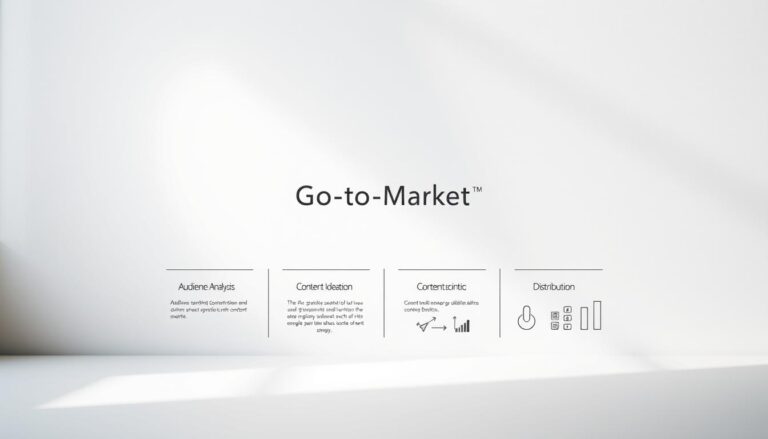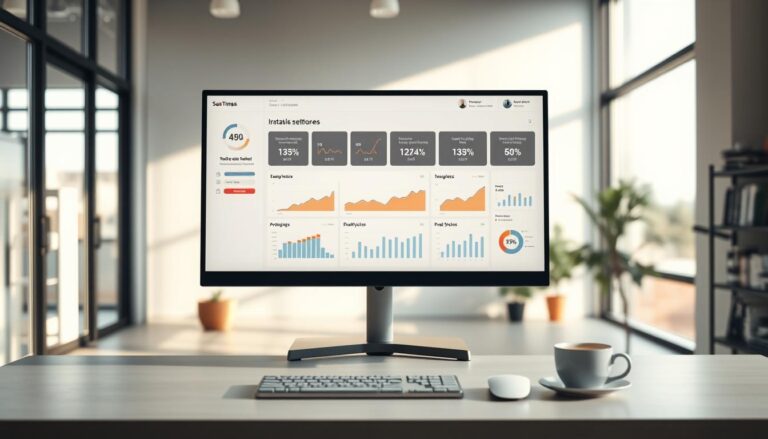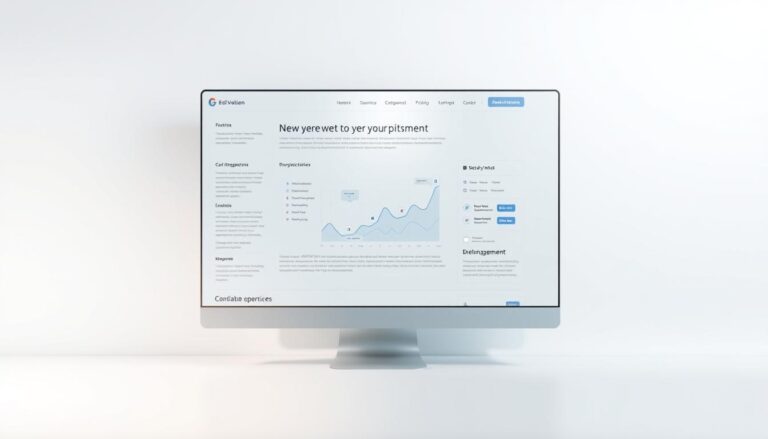Today, most online journeys begin with a search engine. This makes SEO crucial for businesses. Understanding Google’s algorithm and user habits is key to enhancing website rankings.
High-ranking pages on Google are not only content-rich but load quickly too. This meets the growing user demand for speed. Additionally, nearly all Featured Snippets come from the top pages. This shows the need to optimize your website, from its speed to how content is structured.
Video content has become vital because it improves bounce rates. Also, using strategies like sitelinks boosts click-through rates. This deepens user engagement. A well-made piece of content can draw in hundreds or thousands of domain links, as our studies show.
Yet, staying relevant to user intent is essential. This involves focusing on keywords with high commercial intent. Your SEO strategy should also be data-driven and include partnerships. This ensures your efforts meet the needs of search engines and your audience.
Key Takeaways
- Speed optimization is paramount, with top Google search results loading faster and earning Featured Snippets.
- Embedding videos can lead to improved engagement, evidenced by an 11.2% better bounce rate.
- Backlink profiles benefit greatly from creating quality content that organically amasses referring links.
- Targeting the right keywords, particularly those with high commercial intent, can drive valuable traffic.
- A strategic approach to content, including partnerships and multimedia integration, is critical for SEO.
- Continuous monitoring and adapting to evolving SEO trends and algorithm changes ensure long-term success.
Understanding the Importance of SEO Performance
SEO is no simple buzzword. It’s key in the world of digital marketing and is always changing to keep up with the digital race. Good SEO strategies are vital for businesses wanting to be more seen online and get more organic traffic.
What is SEO?
SEO involves a variety of methods to make web content show up high in search engine results. This includes using the right keywords, making websites easy to navigate, enhancing the user experience, and much more. The goal is to be more visible on search engine results pages. This way, more people visit your site without having to pay for ads.
Why SEO Matters for Businesses
In our digital age, a business’s online presence is usually the first thing people see. SEO makes sure your website ranks high when people search for your products or services. High rankings lead to more visitors, credibility, and trust from potential customers. These can deeply affect a business’s profits.
Key Metrics to Measure SEO Success
To fine-tune and succeed in SEO, you must understand and measure its impact. Important metrics include the amount of traffic, how many visitors do what you want them to do, where your keywords rank, and how many sites link back to you. Tracking these can reveal how well your SEO efforts are working. They also guide your future strategies.
Let’s look at some statistics:
| SEO Metric | Statistic | Impact |
|---|---|---|
| Click Rate for Top Search Result | 31.7% | Most clicks go to the top result, showing the importance of being number one. |
| Clicks for Top Three Results | 75.1% | Being in the top three gets you the majority of visits, highlighting the value of good SEO. |
| Performance Against Paid Search | 10 Times Better | SEO beats paid ads hands down, proving it’s a smart investment. |
In summary, mastering SEO isn’t just about playing by the search engine rules. It’s also about creating an online space that’s enjoyable and accessible, encouraging natural growth and higher visibility. For any forward-thinking business, investing in advanced SEO strategies is a must to stand out online in today’s competitive field.
Conducting Thorough Keyword Research
Keyword research is vital for a successful SEO strategy. It involves finding terms people search for. Then, optimize your site to meet those needs. You should explore both long-tail and short-tail keywords. Also, see what the competition is doing.
Tools for Effective Keyword Research
There are key tools like Google’s Keyword Planner, Ahrefs, and SEMrush. They show search volumes and keyword difficulty. They even tell you about your competition. Using these tools helps target the right keywords. It’s about finding the perfect mix of search volume and competition. Tools for analyzing the competition are also useful.
Analyzing Competitor Keywords
Knowing your competitors’ keywords is crucial. Use SEMrush or Ahrefs to find out. This shows where you can improve. Find a niche or perform better using SEO best practices.
Long-Tail vs. Short-Tail Keywords
Short-tail keywords have high search volumes but are competitive. Long-tail keywords are specific and attract targeted users. They lead to more conversions. For example, “paranormal investigators” might bring more interested users than “detective agency.” It’s smart for new websites to focus on long-tail keywords.

Doing thorough keyword research is key. Always update your strategies with market trends. This will help optimize your site and boost SEO.
Optimizing On-Page SEO Elements
Improving your website’s ranking means focusing on on-page SEO elements. Paying close attention to title tags, meta descriptions, and structured content makes pages visible and user-friendly. This keeps visitors coming back.
Title Tags and Meta Descriptions
Title tags are a key part of on-page SEO. Even though they don’t directly lead to top rankings, using target keywords makes your page more relevant. Meta descriptions also help a lot by boosting click-through rates. They need to be short, under 160 characters, and include your keyword, making them stand out in search results.
Header Tags and Content Structure
Using header tags and organizing content well helps both users and search engines. Google says clear headers that highlight main points improve a page’s readability and SEO. This makes your website perform better.
Image Optimization Techniques
Properly optimizing images is vital for good on-page SEO. Having the right image size, using descriptive file names, and adding alt tags boost page speed and relevance. This improves your site’s ranking.
| Element | Best Practice | Impact on SEO |
|---|---|---|
| Title Tags | Include the exact target keyword | Improves relevancy and matches search intent |
| Meta Descriptions | Include keyword, keep under 160 characters | Increases potential CTR with bolded search terms |
| Header Tags | Use clear hierarchy (H1, H2, H3) | Enhances user navigation and content understanding |
| Images | Correct file name, size, and alt tags | Boosts page speed and relevancy for search queries |
Applying these strategies helps websites not just meet but exceed SEO standards. This leads to better SEO performance and higher search engine rankings.
Enhancing Content Quality and Relevance
The way SEO changes highlights why it’s key to keep your website content strong and relevant. It’s vital to understand user needs and link them with content creation. This approach can boost engagement and improve your online presence.
The Role of User Intent
Understanding user intent is more than just focusing on keywords. It means exploring why users search for information. This helps create content that meets their needs. Google looks at factors like Experience, Expertise, Authoritativeness, and Trustworthiness (E-E-A-T). These play a big role in how your content performs online.
Creating Valuable and Engaging Content
- Using a mix of videos, images, and infographics makes your content more engaging. It also helps keep website visitors interested and coming back for more.
- To stand out, make sure your content is unique and offers something different from what others provide. This increases your site’s credibility and the number of visitors.
Updating and Repurposing Existing Content
Keeping your content updated and fresh is essential. Repurposing content aligns with trends and preferences, helping to attract more attention. This approach also boosts SEO by using keywords better and enhancing your authority on topics.
| Factors | Benefits | SEO Impact |
|---|---|---|
| High content quality | Increased engagement, conversion rates, and user satisfaction | Enhances organic reach and ranking in search results |
| Keyword-optimized content | Attracts more relevant traffic, leads to higher discoverability | Improves content’s relevance and SERP positioning |
| Regular content updates | Keeps content fresh and aligned with current information and trends | Positive impact on site visibility and user engagement metrics |

Building a Strong Backlink Profile
Creating effective backlink strategies is key for SEO pros to boost rankings and traffic. A great backlink profile boosts your site’s visibility. It also shows your authority and credibility in your field.
Identifying Quality Link Opportunities
Crafting high-quality content is the first step. This content should be so good that others want to link to it. Examples include detailed guides, reports with lots of data, and insightful research. You can find more about creating link-worthy content at Backlinko.
Building Relationships for Link Building
Reaching out to industry leaders and content creators can up your backlink game. Personalized outreach and being active in forums can spark valuable connections. Aim for partnerships that bring mutual benefits, raising visibility and authority for everyone involved.
Monitoring and Analyzing Backlinks
Tools like Ahrefs or Semrush make it easy to watch your backlink situation. Regular checks help you understand your backlinks better. They let you spot bad links, learn from good ones, and see growth opportunities.
Remember, SEO best practices recommend a natural and diverse backlink profile. It’s important to mix up your link types and sources. Make sure your links are well-placed in content that’s relevant and authoritative.
| Strategy | Description | Impact on SEO |
|---|---|---|
| Quality Content | Develop engaging, informative content that adds value | Attracts natural, high-quality backlinks |
| Relationship Building | Connect with key influencers and content creators | Generates organic backlinks and enhances reach |
| Regular Monitoring | Use SEO tools to track and analyze backlinks | Helps maintain a healthy and robust backlink profile |
Focusing on these backlink strategies can give businesses an edge. They lead to better SEO rankings and more traffic. Ultimately, this helps with online visibility and organic growth, which are key for success in the digital world.
Leveraging Technical SEO Best Practices
In today’s online world, mastering technical SEO is a must for businesses wanting better visibility and engagement online. Mobile optimization and fast site loading are key for good SEO. Let’s explore how to make your site optimal for search engines.
Mobile Optimization Strategies
Smartphones are everywhere, making mobile optimization crucial. It ensures websites look and work well on various devices. Responsive websites rank better on search engines.
Improving Website Speed and Performance
Fast websites please both users and search engines. If a site takes 10 seconds to load, people are more likely to leave. Large images can slow your site down a lot.
Making your website faster keeps visitors happy and helps with search rankings. Optimizing images and fixing slow scripts are key steps.
Fixing Crawl Errors and Broken Links
Search engines need to read your site easily to show it in results. Fixing broken links and errors is important. It keeps your site running smoothly and maintains its reputation.
| Issue | Impact on SEO | Best Practice |
|---|---|---|
| Slow Site Speed | Increases bounce rate, affects user engagement | Optimize images, minimize HTTP requests |
| Crawl Errors | Prevents pages from being indexed | Create accurate XML sitemaps, check for broken links |
| Mobile Unoptimization | Decreases mobile user engagement, lowers rankings in mobile searches | Implement responsive design, adjust content visibility |
Following technical SEO best practices improves user experiences and search rankings. Keep your site updated with these methods to stay competitive online.
Continuous SEO Monitoring and Improvement
SEO is always changing, so businesses need to stay alert. Keeping your website up to date is crucial for success. This means using detailed analytics and being quick to make changes. By doing this, companies can ensure their websites meet new SEO trends and user needs.
Tools for SEO Performance Tracking
To excel in SEO, you must have the right tools. 86% of content marketers look at organic traffic to measure success. Tools like Google Analytics, SEMrush, and Ahrefs help track site traffic and the quality of backlinks. They show how well content is doing. For example, top-ranked Google pages are usually 3.5 years old, highlighting the value of long-term efforts. It’s also important to check the ROI of your SEO work, which can grow drastically over three years.
Conducting Regular SEO Audits
Regular SEO audits help find and fix any issues. These checks focus on content relevance and technical SEO areas. For instance, problems like crawl errors and broken links hurt your Google ranking. So, fixing these improves your website’s speed and how well it works on phones, helping your site’s visibility and user experience.
Adapting to SEO Trends and Algorithm Changes
In SEO, it’s vital to adapt to stay ahead. Search engines, especially Google, often update their algorithms. These changes can quickly affect your search rankings. By keeping up with these updates, you can adjust your SEO plan to avoid losing your place in search results. Adopting new trends like voice search and understanding user behavior are also key. They help you tailor strategies to keep your audience engaged, driving growth and better visibility.
FAQ
What is SEO?
SEO stands for Search Engine Optimization. It uses various tactics to increase a website’s visibility on search engine results. By improving the site’s content, structure, and technical aspects, it aims to draw more visitors. This process helps sites rank better on search engines like Google.
Why does SEO matter for businesses?
SEO is vital for businesses because it boosts online visibility and user engagement. High rankings in search results can attract more visitors. This can increase sales, brand recognition, and revenue. With a strong SEO strategy, businesses can effectively reach more customers.
What key metrics should be used to measure SEO success?
To measure SEO success, look at organic traffic, keyword rankings, and backlinks. Also, check click-through rates and conversion rates. These metrics show if an SEO strategy works well. By monitoring them, businesses can make smart decisions to improve.
Which tools are effective for keyword research?
For keyword research, use tools like Semrush, Ubersuggest, Google Keyword Planner, and Ahrefs. They offer insights into search volumes, competition, and keyword difficulty. This information is crucial for creating a strong SEO strategy.
How do you analyze competitor keywords?
To analyze competitor keywords, SEO experts use tools like Semrush and Ahrefs. They study search results to understand content trends. This helps to create better content that can rank above competitors.
What’s the importance of long-tail versus short-tail keywords?
Long-tail keywords are specific and usually less competitive than short-tail ones. They may attract more targeted visitors and higher conversion rates. In contrast, short-tail keywords are broader and harder to rank for but can bring in more traffic. Using both types of keywords is most effective.
How should title tags and meta descriptions be optimized?
Optimize title tags and meta descriptions with relevant keywords. Title tags should describe page content briefly. Meta descriptions need to be appealing and provide clear information to encourage click-throughs. They must fit length guidelines for best results.
What role do header tags and content structure play in on-page SEO?
Header tags and content structure are key to on-page SEO. They help search engines and users understand content better. Using header tags for key points and making content easily navigable can boost SEO and readability.
What are the best image optimization techniques?
For image optimization, compress files, use descriptive names and alt texts with keywords, and pick the right file formats. Making images responsive and using next-gen formats also helps SEO.
How do you ensure content aligns with user intent?
Aligning content with user intent means knowing what users search for and providing it. This could be answers to questions, in-depth guides, or analysis. It’s about meeting the searcher’s needs with your content.
What methods can be used to create engaging content?
Create engaging content by using original research and including multimedia. Tell compelling stories and provide actionable advice or solutions. Encouraging user interaction through polls, quizzes, or comments can also increase engagement.
How should existing content be updated and repurposed?
Update and repurpose content by refreshing it with the latest information and trends. You can turn old posts into new formats and update facts. Adding multimedia can make the content more interesting and useful.
How do you identify quality link opportunities?
Finding quality link opportunities involves spotting gaps in your niche and filling them with great content. Then, connect with websites and influencers who might share your content because it’s valuable and relevant.
How does building relationships help with link building?
Building relationships is crucial for link building. It means connecting with others in your industry who can provide strong backlinks. By networking and sharing great content, you can earn natural, high-quality links.
What should be monitored when analyzing backlinks?
Monitor the number and quality of backlinks, the authority of linking domains, and the relevance of links. Watch out for harmful links that can damage your SEO. This helps maintain a healthy backlink profile.
What mobile optimization strategies should be implemented?
For mobile optimization, make sure your site works well on all devices. Speed up loading times and design for touch navigation. Focus on mobile users’ needs, use AMP, and optimize for local search to improve the experience.
What steps can be taken to improve website speed and performance?
Boost website speed by optimizing images, minifying code, and using browser caching. Employ CDNs and choose fast hosting to reduce loading times. These actions enhance site performance significantly.
How do you fix crawl errors and broken links?
Use tools to find crawl errors and broken links. Google Search Console is good for crawl errors, and a broken link checker can find dead links. Fix these issues with redirects or by updating links.
What tools are available for SEO performance tracking?
Google Analytics, Semrush, Ahrefs, Moz, and Google Search Console are great for tracking SEO. They help monitor organic traffic, keyword rankings, backlinks, and user behavior. This data is key to improving your SEO efforts.
Why is conducting regular SEO audits essential?
Regular SEO audits reveal weaknesses and opportunities in your strategy. They help you find technical issues, content gaps, and on-page flaws. Addressing these can enhace your search rankings and user engagement.
How should businesses adapt to SEO trends and algorithm changes?
Stay up-to-date with SEO trends and Google’s algorithm updates by following industry news and blogs. Adjust your strategies accordingly, focusing on keywords, technical SEO, or new search technologies like voice search and AI.



